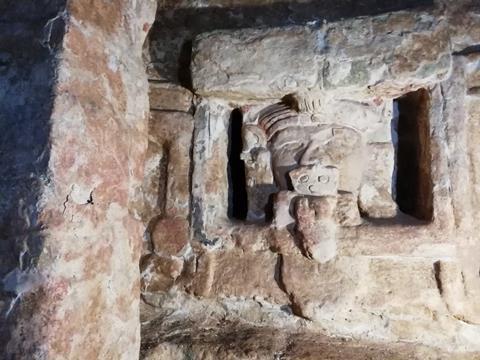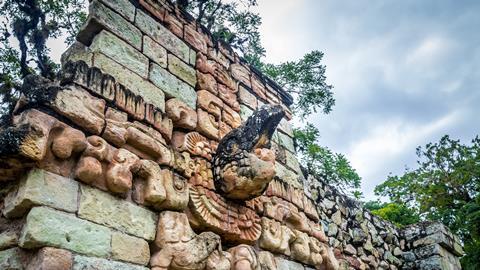Why are buildings of the Romans and Mayans in such good condition after hundreds, sometimes even thousands, of years? Two new studies offer insight into the past and hope for the future.
Everything was better in the old days. It sounds like a cliché that all older generations across the globe have used throughout eternity. But like any cliché, it contains a core of truth, especially when it comes to antique lime-based building materials that sometimes prove to be amazingly durable. According to two recent studies, both published in Science Advances, the possible explanations for the engineering achievements of the Romans and Mayans are surprisingly low-tech.
The Romans may not have invented concrete, but they certainly maximized its potential. Their structures had heights and spans that were impossible before. The basis for the Roman concrete revolution, which began in the late third century BCE, was the reaction between volcanic ash, rich in silica and alumina, with slaked lime (Ca(OH)2) and water. This so-called ‘pozzolanic’ reaction - after the city of Pozzuoli, in the Bay of Naples - leads to a very sturdy and versatile building material, but it does not necessarily explain its longevity. A different process had to be at the heart of this.
Heterogenous composition
Admir Masic, associate professor of civil and environmental engineering at the Massachusetts Institute of Technology (MIT), tested samples of Roman concrete from the second century BCE with an international research team, to unravel the building material’s secret. ‘What struck us in those samples were the ubiquitous, millimeter-sized white fragments of lime,’ Masic says. These so-called clasts, grains of one material embedded in another, had been known for some time, but were generally considered impurities. ‘Our idea was that these lime clasts, which you see in almost all published cross sections of Roman concrete, were added on purpose and played an important role in the properties of the material.’

Studying the material with an electron microscope and analytical methods such as Raman spectroscopy, giving information about the molecular structure of the samples by its interaction with light, revealed that the lime clasts have a porous structure and, in addition to calcite, consist of several other types of calcium carbonate (CaCO3), which are also found in the rest of the concrete. Masic: ‘This heterogeneous composition of the material is typical of a formation with high temperature and relatively low humidity. In a normal equilibrium reaction, you wouldn’t see that.’
The team suggested that the lime inclusions and their specific composition were caused by a process known as ‘hot mixing’, in which quicklime is added during the mixing process. The name comes from the fact that it’s an exothermic reaction. ‘It would explain so much,’ Masic says. ‘Not only the specific chemical compounds we find, but also the speed with which the Romans built those walls. The concrete hardens faster through this process; after a day you can walk on it.’

Cracking cylinders
Moreover, the clasts would form a reactive source of calcium giving the concrete self-healing properties. Masic: ‘Water penetrating the concrete comes into contact with the clasts, which partially dissolve, providing calcium ions that then crystallize back into calcium carbonate, thus filling the cracks. Or they react with elements from the volcanic ash and strengthen the internal structure of the concrete in that way.’
To test that hypothesis, the researchers made cylinders of modern concrete, with and without the addition of quicklime. They broke the cylinders in half and allowed water to pass through the crack. In the cylinders made with quicklime, the water was found to systematically stop flowing through the cylinders after two to three weeks. The researchers thus showed that cracks repaired themselves that would never do so in regular modern concrete because they are too wide. Masic: ‘Analytically, the lime clasts in these cylinders closely resembled those in ancient Roman concrete, with a core of calcium carbonates and a hydrated, reactive rim. Moreover, the filling of the cracks appeared to consist of pure calcite, which we have also found in filled cracks in Roman concrete. We think that is due to reactions with the clasts.’
The question remains to what extent the reconstructions fully match the properties of the ancient material. Masic: ‘Would Roman concrete that I take from the Pantheon heal if I run water through it? I have no idea! But through our experiments we have confirmation that it can be done.’ Masic does not rule out further research: ‘We have now added the quicklime to modern recipes, we have not tried to follow ancient Roman recipes. It would be interesting to do that and analyze the result in a similar way.’
Tree bark
On the other side of the Atlantic, many Mayan lime plasters have stood the test of time in equally impressive fashion. Carlos Rodríguez-Navarro, professor of Earth Sciences at the University of Granada, and a research team investigated samples of seventh-century CE lime plaster and mortar from the Copán archaeological site in Honduras to find out what could explain this surprisingly good state of preservation.

It was suspected that the addition of natural, organic materials might play a key role. Sixteenth-century sources already record that the local lime mortar was so strong because it was made with ‘a kind of water derived from a tree bark’. But it was unknown why it would then have those properties, and there was no conclusive evidence that the classical Maya used the same technology centuries before. While researchers had found organic material in plaster and mortar, they mostly attributed it to bacterial activity.
Samples of exceptionally well-preserved lime plasters from Copán were indeed found to contain organic materials using spectroscopic analysis. Examination with an electron microscope showed that at the nano-level they had a rough, granular structure that differed from the smooth, regular structure of pure calcite. Reconstructions of lime plasters made by the team, with and without added bark extract, were found to show the same difference.
Intentional additions
‘We were able to demonstrate the presence of polysaccharides inside the calcite crystals,’ Rodríguez-Navarro says. The research team did so with research at synchrotron ALBA, a particle accelerator near Barcelona. ‘The only way to achieve this is if they mixed those bio-additives with the lime during slaking, otherwise you would only find them on the surface, outside the crystals. Our study is thus the first to show that the Mayans at that time must have intentionally added organic material to the lime mortar’

‘The additives appear to act as crystallization inhibitors,’ Rodríguez-Navarro explains. ‘They cause amorphous calcium carbonate particles, that later transform into stable crystal forms like calcite, to survive longer. Thus, the crystals that eventually form retain this somewhat amorphous structure. It is a biomimetic material, which can be compared to biominerals of calcite of which many shells are made in nature’. Further tests showed that the final lime plaster dissolved less quickly under the influence of water and was thus more resistant to the elements. The material was also found to have better plastic properties: it could deform more strongly under pressure without actually cracking.
Rediscovery
How the Maya got the idea to add those bark extracts we will never know. Possibly the lime mortar dried too quickly, causing cracks, and so they came up with the idea of adding a sticky substance. ‘Probably they knew very well what they were doing, and through trial and error arrived at an optimal recipe,’ Rodríguez-Navarro believes. ‘There is a convergent evolution in that regard. For example, in China they added sticky rice to lime mortar, and elsewhere in the world ancient peoples also tried to use organic materials to influence the properties of their building materials.’
‘We are rediscovering these techniques now,’ Rodríguez-Navarro said, ‘because we want more appropriate materials for restoration purposes, but also sustainable alternatives for modern construction.’ Masic sees the same promising future: ‘In less wealthy countries, we are not going to find the solutions to problems in expensive industrial plants. There are so many local, traditional solutions that are cheap and proven to be effective that we can improve even further using modern science and engineering. That’s the key to a sustainable future.’
Linda Seymour, et al, Hot mixing: Mechanistic insights into the durability of Ancient Roman Concrete, Science Advances (2023) [Open Access]













Nog geen opmerkingen